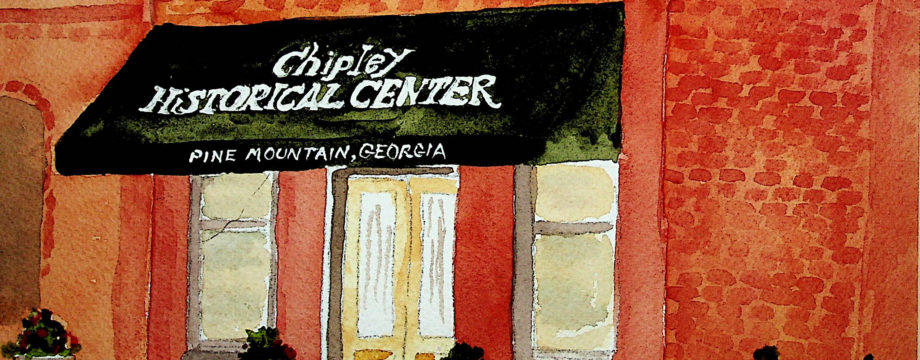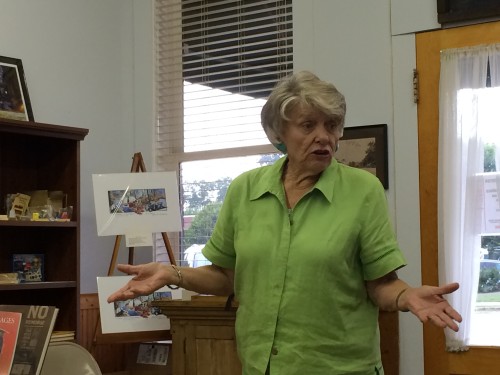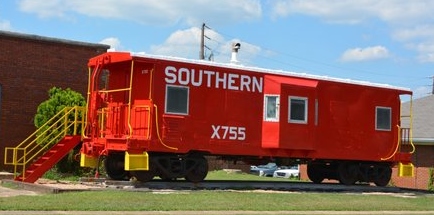Our board has proposed bylaws changes. These can be viewed here or you can pick up a copy at the Chipley Historical Center.
Author Donates Research Materials
Dot Moore, Author of No Remorse: The Rise and Fall of John Wallace spoke to a crowd of over 30 people on July 10, 2015 at the history center. She thought people in the audience, mostly from Pine Mountain, might have known John Wallace better than she, so she told what she knew of his sister, Jean. His sister was a very lovely woman, married 5 times and inherited fortunes from all of her husbands. But in her will, she returned what she inherited to each of those families. Jean didn’t think her brother John was guilty of murder, but rather caused an accidental death. The jury disagreed and John Wallace was eventually put to death by electrocution. Ms. Moore donated all of her research materials for writing the book to the Chipley Historical Center.
History of the Chipley Woman’s Club
Sue Trott presented the history of the Chipley Woman’s Club to an audience gathered at the Pine Mountain City Hall on Sunday April 26, 2015. The presentation was sponsored by the Chipley Historical Center in Pine Mountain.
The Chipley Woman’s Club began 102 years ago. Many of the original founders are ancestors of current members.
In the beginning, the women met in each other’s homes. Later they were able to purchase land and eventually build the club house that still exists and is used today. Once the club house was built it became the center of activity in Chipley.
A ball field with lights, tennis courts, a skating ring and playground were installed. The only one of these that still exists today is the skating rink, but it not in any condition to use for skating.
The women planted a memorial garden of pecan trees to honor WWI veterans. Ironically, today the Woman’s Club has planted another memorial garden under those pecan trees.
From the beginning, the Woman’s Club was very involved with trying to improve life in Chipley. They paid for various school programs, worked on what is now the Pine Mountain Cemetery, planted a flower garden in the center of Broad Street, worked to clean the area to reduce flies and mosquitos, and built restrooms for the tourists.
Mrs. Trott’s presentation was very informative.
Bay Window Caboose
The crew monitoring the train sits in the middle of the caboose in a section of wall that projects from the side of the caboose to resemble bay windows.
This afforded a better view of the side of the train. The bay window type gained favor with many railroads because it eliminated the need for additional clearances in tunnels and overpasses.
The seat is arranged so that the Conductor can brace himself to protect himself form slack run in & out.
Until the 1980s, laws required that all freight trains have a caboose and a full crew, for safety. Technology eventually advanced such that the railroads, in an effort to save money and reduce crewmembers, stated that a caboose was unnecessary, since there were improved bearings and track side detectors to detect HOT BOXES and Dragging Equipment. The railroads also claimed that a caboose was a dangerous place, as slack run-ins could hurl the crew from their places and dislodge weighty equipment. The caboose was replaced with EOTD (End-of-Train Device). Cabooses were no longer needed. The EOTD radioed info to the locomotive.
Indians originally occupied this area
Originally this land, around Pine Mountain and in West Georgia, was inhabited by the Creek Indians. In 1825 at Indian Springs, Georgia, Chief McIntosh signed a treaty ceding the land to the U. S. Government. Other Creeks disagreed and killed McIntosh.
More treaties were signed and by 1826 the Creeks had crossed the Chattahoochee River into Alabama, where they remained for about a decade before moving further west.
The Old Jail in the Historical Center
Our volunteers have lots of interesting stories and I am sure they will share soon.
The old jail cells, with the graffite on the plastered walls, get lots of comments from visitors.
John Owings, Jr., lived in Pine Mountain when his dad was manager of the Dacula plant.
While his dad was in the old city hall one day paying his water bill, young John took his pen knife and scratched his name on the plastered wall with with comment ‘John Owings, age 11, killed 12′. Killed what? Bugs?
The family moved away shortly after then. We heard several years later that young John had gone into the ministry.
In 1987, my husband and I spent part of the summer with our daughter Marjorie and her family in Italy where her husband was stationed with a military medical detachment..
One Sunday we decided to go to the Protestant service on post and I almost jumped out of my seat when I noticed that John Owings was listed as the minister.
I signed the visitors card and when it was handed to John, he asked the organist to continue playing while he came down to talk to us. I asked if he remembered scratching his name on the old cell wall in Pine Mountain. He said he did. He told us he was a chaplain with the paratroopers and that he jumped with them. We had lunch with him and his family and he promised to get in touch with us when he returned to the states. He became director of Georgia military chaplains and was stationed at Fort McPhearson.
A few years ago our Historical Center invited him to be the speaker for one of our annual veterans day programs. He showed up in his military uniform with a array of ribbons and medals.
I received an invitation to attend his retirement celebration near Atlanta. I was unable to go but I gave a contribution to our Historical Center in his honor and told him he would always be remembered as being in the jail cell..
Posted by L. Champion
The volunteers are full of stories
I wonder if they’ll tell them here?





